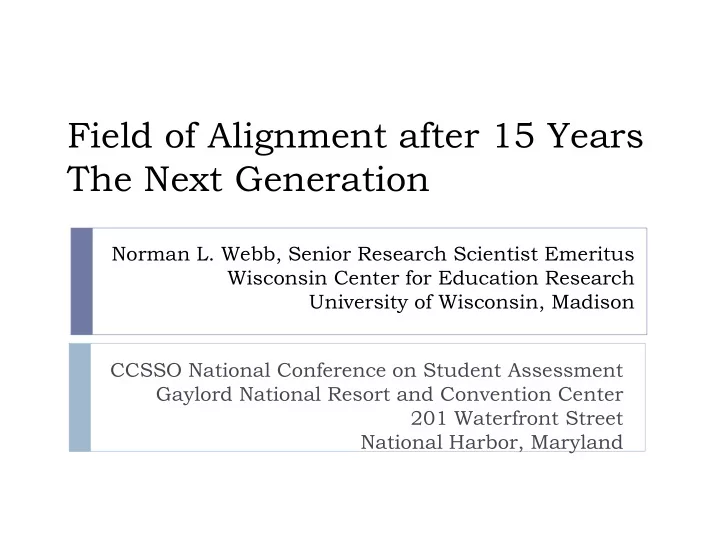

Field of Alignment after 15 Years The Next Generation Norman L. Webb, Senior Research Scientist Emeritus Wisconsin Center for Education Research University of Wisconsin, Madison CCSSO National Conference on Student Assessment Gaylord National Resort and Convention Center 201 Waterfront Street National Harbor, Maryland
Overview Current Status of Alignment • Alignment Issues • Alignment for the Future •
Current Status of Alignment
Approaches to Alignment Analysis • Survey of Enacted Curriculum (SEC) – Index/landscape • Webb – Criteria centered • Achieve – Criteria with qualitative analysis
Rank Order of the SEC and WAT Alignment Analyses Least Aligned to Most Aligned Sec B5 C4 C5 B3 B4 C3 A4 A3 A5 WAT B3 A3 B5 A4 B4 C5 C4 C3 A5 Newton, J. A., & Kasten, S. E. (2013). Two models for evaluating alignment of state standards and assessments: Completing or complementary perspectives? Journal for Research in Mathematics Education, 44 (3), 550-581.
Alignment Issues • Interpretation • Precision • Expansion
Interpretation of Alignment Analyses • Decision rules (currently) • Simulations of different levels of alignment and reliable decisions about student • Correlational studies on degrees of alignment and facilitation of student performance
Alignment Attributes Up for Consideration Minimum number of items for a • reporting category Content complexity agreement • between items and standards (DOK) Coverage of domain of knowledge • (range) Variation of emphasis •
Precision — Unit of Analysis • Generally determined by the structure of the standards • Degree of alignment is reported by aggregating over the unit of analysis • Alignment results would be more precise if unit of analysis was more detailed
Precision — Partial Matches • An item targets a part of an objective • Only some objectives are hit • More accurate analysis of range
Precision — Reviewer Agreement • Lack of agreement can be due to poor alignment • High reliability can mask alignment problems • Multiple groups of reviewers can replicate results
Expansion
Computerized Adaptive Testing • Extending analysis beyond grade level • Alignment relates to item pool, blueprint, and selection algorithm • Sample of test events for analysis
Increased Variety of Tasks • Performance tasks • Different weighting of tasks • Nested tasks (e.g. draw an inference then ask for evidence)
Increased Purposes of Assessments • Interim assessments • Student growth or value added models • Prediction rather than proficiency • Teacher evaluation and classroom sampling
Relevance of Alignment for the Future • Standards-based Accountability System • Readiness Accountability System • Growth Accountability System
Recommend
More recommend